What Is Chondromalacia Patella?
Chondromalacia Patella refers to the softening and breakdown of the articular cartilage on the undersurface of the kneecap (patella). This cartilage normally allows the kneecap to glide smoothly over the femur. When it softens or deteriorates, it can cause pain, inflammation, and grinding sensations during knee movement.
While it’s sometimes used interchangeably with Patellofemoral Pain Syndrome (PFPS), chondromalacia specifically refers to structural cartilage damage, whereas PFPS may not.
Who Is at Risk?
Chondromalacia Patella is especially common among:
-
Adolescents and young adults
-
Runners, cyclists, and athletes in high-impact or repetitive sports
-
People with previous patellar dislocation or instability
-
Individuals with muscle imbalances, malalignment, or flat feet
Symptoms
-
Pain at the front of the knee, especially behind the kneecap
-
Worsening pain with stairs, squatting, kneeling, or prolonged sitting
-
Grinding or cracking sensations (crepitus) when bending the knee
-
Occasional swelling after activity
-
Stiffness or difficulty fully straightening the leg
Causes and Contributing Factors
Chondromalacia can be triggered or worsened by:
-
Poor patellar tracking due to muscle imbalance or alignment issues
-
Overuse from repetitive motion (e.g., running, jumping)
-
Kneecap trauma, such as falls or direct impact
-
Weak hip or thigh muscles
-
Tight hamstrings or IT band
Diagnosis
Diagnosis begins with a physical exam focused on:
-
Patellar mobility
-
Quadriceps strength
-
Signs of malalignment or tracking issues
Imaging such as X-rays or MRI may be used to:
-
Assess cartilage quality
-
Identify patellar positioning issues
-
Rule out other causes of knee pain
Treatment Options
Non-Surgical Treatment
Most patients respond well to conservative care:
-
Physical therapy to:
-
Strengthen the quadriceps and hip stabilizers
-
Improve patellar tracking
-
Increase flexibility in the hamstrings and IT band
-
-
Ice and NSAIDs to reduce inflammation
-
Activity modification: Avoid deep squatting, stairs, or prolonged sitting
-
Orthotics or taping for alignment correction
-
Patellar bracing to improve tracking
Surgical Options (For severe or non-responsive cases)
-
Arthroscopy to remove damaged cartilage or smooth surfaces
-
Lateral release if tight lateral structures are pulling the patella out of alignment
-
Cartilage restoration procedures (in select cases)
Recovery and Prognosis
-
Most patients improve in 6–12 weeks with proper rehabilitation
-
Long-term results are best with consistent strengthening and alignment correction
-
Return to sports is possible but may require modification in training habits
Kerlan Jobe Institute’s Approach
At Kerlan Jobe Institute, we recognize the importance of individualized care. Our specialists conduct a thorough biomechanical assessment to target the root cause — not just the symptoms — of patellofemoral cartilage pain.

